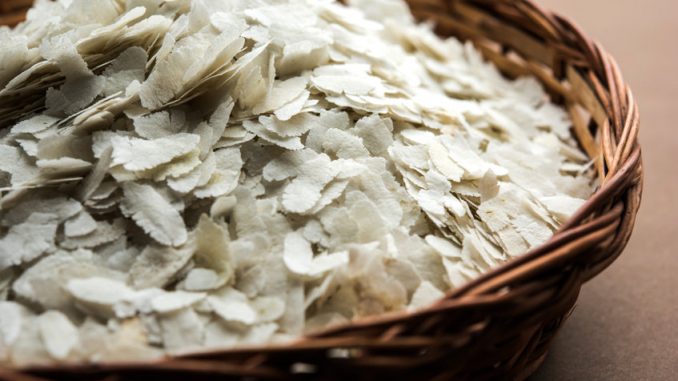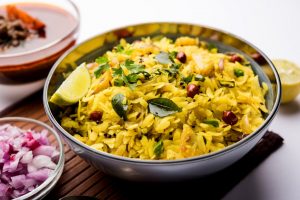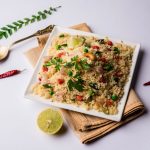
Poha might just be what you need to eat for breakfast if you are looking to lose weight. It might also make breakfast a little bit more exciting and entertaining too.
To European eyes eating what is flattened or beaten rice might not be the most immediate solution on a dieting plan. It is a food however which has been eaten for centuries in India very often at breakfast and many on the sub-continent believe it deserves some credit for helping many in their battle against developing flab.
Poha is also popular at other times of the day and has a level of versatility that is not often appreciated globally. When I’m checking out recipes for foods that I’m not that familiar with I often scan the news and social media for what is trending. Beaten rice regularly turns up. It appears highly versatile and there are many recipes using poha that have a universal versatility.
It needs to be appreciated that poha has many other names depending on which part of India you happen to live in. It also accounts for the great variety of recipes which are also region specific. This type of rice is known for example as chiwda in many parts but also as chuda in Oria, it is chire in Bengali dialects, in Tamil they call it aval, a related name is avalakki in Kanada and in Bhojpuri it is chiura. As I see it this type of prepared rice has been given a few different names over many years but they all amount to the same type of ingredient – it’s a case of knowing how you intend to cook with it.
From a dietary perspective a number of readers describe poha for breakfast as something that is easy and light on the stomach. Enjoy whatever poha you make with a cup of tea or coffee. Tea is preferable!
Preparing Poha For Cooking
When preparing poha for cooking just rinse it through with running water. The rice is held in a sieve. The poha will soften gradually. These flakes should loose their crunchiness and when you break them between your finger, they should easily get crushed or mashed. Don’t let them get too wet as they will lose their structure completely and just fall apart.
Doi Chire (Poha With Yogurt And Fruit)
Here is a recipe that came up from a client of mine which is doi chire. Being from Bengal they were adapting doi chire which is basically flattened rice with a good helping of yogurt (doi) along with fruit and other ingredients to generate some sweetness. This highly palatable mixture can keep you going almost throughout the entire day. The yogurt which is known as doi should preferably be misti doi but I’ve substituted with Greek yogurt instead (a bit of Euro-India trade-off). Traditionally, sugar drop candies which are not often available in the UK are added. The Bengalis call them batasha which you sometimes see in older recipes to create some sweet crunch.
It’s quite simple to put together:
Ingredients:
- 1 cup of flattened rice
- 1.5 to 2 cups of yogurt (doi)
- Sugar, coconut sugar, sugar syrup and/or honey according to taste
- 1 banana, sliced
- Some nuts, dates and raisins, chopped
- figs are added as an option
- Fruit such as peach slices, pear, apple, mango or any other choice as a garnish
Preparation:
- Prepare the flattened rice as mentioned above.
- Add sugar or whatever sweetener you care for according to taste.
- Add yogurt to it and mix thoroughly.
- Add nuts, raisins, dates, figs, sliced banana and mix lightly in.
- Garnish with some fruits of your choice and serve.
Kanda Poha
Maharashtrian-style poha is a popular breakfast dish. Is it a staple? Probably given that many consumers eat it in Northern parts of India too. My Indian friends reguarly suggest this one . They have often made it by adding onions to poha and then adding nuts with a golden-yellow sev. Sev is a crunchy besan noodle snack which we tend to buy in rather than make. I must admit we’ve added other types of snacks too so the definition of a sev has become very lax. To add a touch of spiciness a number of chefs like to accompany this dish with chutney. We also add peas, broad beans, some potato which makes it like an aloo and other vegetables probably deserve an outing too.

The poha used here should be reasonably be thick to absorb plenty of flavour. It can also be white or red.
Ingredients:
- 1.5 cups poha
- ½ cup finely chopped onions, scallions or shallots
- ¼ teaspoon turmeric powder
- 1 teaspoon mustard seeds
- 2 to 2.5 tablespoons salted or unsalted peanuts
- 10 to 12 curry leaves
- 1 teaspoon chopped green chillies or habanero/serrano peppers. We’ve also used hot padron peppers too.
- 1 teaspoon sugar added to taste
- 2 tablespoons oil. Any sort such as sunflower, peanut or any neutral tasting oil but not sesame or coconut oil.
- salt as needed
For Garnish:
- 1 teaspoon lemon juice or add a slice of lemon (see picture) as required
- 2 to 3 tablespoons coriander (cilantro) leaves
- 2 to 3 tablespoons grated coconut added as needed
Preparation:
- Dry roast the peanuts in a heavy pan till they become crunchy and keep them on the side.
- Rinse the poha in running water through a sieve as mentioned earlier.
- Add sugar, salt and turmeric powder to the poha and gently mix together.
- Heat the oil in the same pan and start by sizzling the mustard seeds, followed by the onions and sauté all of this until the onion becomes soft and translucent.
- Add curry leaves and green chillies.
- Sauté for half a minute then add the peanuts along with the poha.
- Cover and steam the poha for 2 minutes on a low level of heat.
- Remove from the heat and leave the kanda poha to rest. Keep it covered for between 1 to 2 minutes.
- Remove the lid and sprinkle some lemon juice, coriander leaves and grated coconut on the dish.
- Give a gentle stir and serve the hot kanda poha.

Leave a Reply